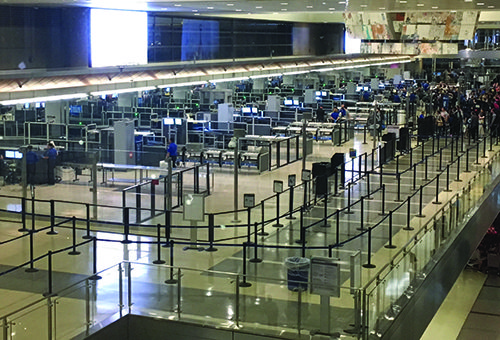With a whopping 85.5 million annual passengers, Los Angeles International Airport (LAX) is considered the second-busiest airport in the United States. But at the end of March, the bustling facility ranked first in the nation for the number of automated screening lanes (ASLs) it has in place.
By mid-April, the airport was already experiencing positive results. “We are seeing reduced wait times and as much as a 30% increase in the number of passengers we are able to screen, compared to a standard lane,” says Aura Moore, deputy executive director, chief information officer for LAX. With the new lanes in place, 1,000 more passengers per hour can be screened through the checkpoint, she adds.
Fast Track Project
In March, the airport opened the final two of 14 ASLs in its Tom Bradley International Terminal to slash security wait times and improve the passenger experience; but these ASLs are not firsts for the airport’s nine passenger terminals. The technology is also installed in terminals 2, 4 and 7, putting the total number of ASLs at 27.
|
facts&figures Project: Automated Screening Lanes Location: Los Angeles Int’l Airport Terminal: Tom Bradley Int’l Terminal Design & Installation: General Dynamics Information Technology Consultants/Systems Integration: K2 Architect: Lamb Associates Electrical: PBS Engineering Structural Designers: VCA Engineering
Equipment Manufacturer: McDonald Humfrey, Cost: $12.3 million
Funding: Airport capital funds; $6.8 million Timeline: Design & planning began Jan. 2017; construction began in July 2017; project completed in March 2018 |
The installation in the Tom Bradley International Terminal is the airport’s largest installation of ASLs from McDonald Humfrey, and the one having the biggest impact, states Moore. Before the new lanes were installed, that particular checkpoint suffered from lengthy wait times. Further complicating matters was the fact that the terminal lacks a large queuing space. “When queues are too long, and wait times exceed 30 minutes, it gets disruptive and impacts the passenger experience,” Moore explains.
With passenger experience, security, safety and facility improvement as LAX’s four strategic goals, this situation needed to change, she explains.
“Improving the passenger experience at this checkpoint was definitely one of the ‘moving-the-needle’ initiatives we needed,” says Moore, noting that the airport had tried to expedite security screening in other ways, including adding a TSA K-9 unit.
While deploying a K-9 unit helped, Moore says it was not a process that could “sustain passenger growth in the long-term.” Airport officials began seeking a technological solution and uncovered the answer while studying ASLs in action at Hartsfield-Jackson Atlanta International Airport.
“We saw they were screening more passengers using those lanes than a standard lane,” Moore says. “In a standard lane, the TSA can process about 150 passengers per hour; and they were processing well over that number, even though it was an early trial and their TSA agents were still getting familiar with the new technology.”
Securing a grant to cover part of the cost to add the technology propelled the $12.3 million project into motion and put it on the fast track. The airport, which covered the balance of the project’s costs with LAX capital funds, began planning and design in January of 2017, started construction in July 2017, and completed the project this March.
Automated Security Screening
At a typical checkpoint, passengers grab bins, place their belongings into them, and then push the bins across roller tables into an X-ray machine. At this point, they then get in line for screening by the body scanners.
With the ASLs, five passengers can divest at the same time. “It’s not that single-file line, where one person has to wait for the next person to divest their personal items,” explains Keith Jeffries, the TSA federal security director at LAX. “Five people can do it simultaneously.”
He explains that with the new automated lanes, passengers walk up to one of five positions, pick up a bin from a shelf underneath, put the bin on a shelf in front them, and the system automatically pulls it in. The unit X-rays bags and automatically diverts suspicious items into a separate area for manual inspection. After passengers leave their belongings, they move directly to a body scanner or metal detector.
The system greatly increases security, says David Borges, director of K2’s Security Solutions Group, the consulting firm retained by the airport to handle systems integration for the project. “Passengers, once they slide their bin forward, have no more control over their belongings until they are clear. They can no longer reach in and grab stuff, like they can do now,” he notes.
The ASLs have two conveyor belts—one that brings empty bins to passengers and one that takes full bins to the scanner—from each divestiture position. This keeps lines moving even when individual passengers are slow to divest their belongings, explains Borges.
Bins in the new lanes are 25% larger than standard, and each is equipped with an RFID tag to provide a one-to-one correlation with the X-ray images. This provides greater flexibility when a bag needs manual inspection, notes Moore. TSA agents no longer move suspicious bags themselves; the system automatically diverts them off the main system into the back system, where they are checked by other TSA officers. This keeps the line moving, even when a bag needs further inspection. The X-ray images travel with bags for manual inspection to the separate screening area.
“It doesn’t have to be checked at the same lane it was screened by X-ray,” she explains. “And, the RFID tag ensures bags and images do not get mixed up.”
The new lanes play a huge role in relieving traveler stress—especially for passengers who need a little more time, adds Moore. “They do not feel as rushed,” she explains. “With standard lanes, passengers had to wait for the person ahead of them. Now, they don’t have to wait. They can take their bag to another divest position to get it checked.”
Given the new ASL options, standard lanes may appear unnecessary; but Moore explains that standard lanes are needed to process larger items, such as strollers and car seats, which do not fit into bins. Tom Bradley International Terminal has two standard lanes for this purpose.
 Beating the Budget
Beating the Budget
“The project came in ahead of schedule and under budget,” reports Moore, who reminds that all work had to be done in a working security checkpoint.
Moore attributes the project’s minimal impact on travelers to excellent collaboration and partnership between Los Angeles World Airports, TSA and the contractors involved, who met weekly.
“We also had a very thorough planning and design process,” she adds. This was especially important because of the small footprint of the checkpoint, which has structural columns throughout that could not be moved, and the size of the new security lanes, which are larger than the existing ones.
“We had to do a very detailed plan and specifically lay out where these lanes would go, because they had to be in different positions than the existing lanes to fit,” explains Moore. “There were some that required us to work with the manufacturer to modify the lane configuration slightly to fit around the columns. It took us around seven months to go through this detailed planning and design process. It was almost like building a new checkpoint.”
To further facilitate the process, the airport used the same contractor team, led by General Dynamics Information Technology, throughout the entire project, instead of using one for planning and design, and another for construction. “This project delivery approach minimized change orders,” she reports. “This is a new technology, and not something that is mainstream yet.”
General Dynamics, in turn, used subcontractors that had already worked on ASL projects in the airport’s other terminals. “This way we were working with contractors who were already familiar with the technology,” she says.
Moore notes that the airport kept TSA involved every step of the way, which also added to the project’s success. Because construction took place in an operating checkpoint, installation of new lanes was carefully phased with TSA. “The detailed phasing plan was all laid out upfront,” she remarks.
Borges highlights the collaboration that took place to make the project successful: “We teamed with LAWA, McDonald Humfrey, General Dynamics, the TSA, and everything went on without a hitch, on schedule, under budget—and it all works perfectly.”
Scheduling minute details helped keep the airport functioning well during construction, he adds. “Tom Bradley is one of the busiest checkpoints at LAX. The lines are usually crazy long, so we had to do a throughput analysis to figure out how many lanes could be taken down at a time without negatively impacting throughput.”
The project was completed in seven phases, two lanes at a time. Crews walled off a section, broke down the area to the X-ray machine, and then installed and tested the new McDonald Humfrey system before bringing the lane back online. In addition, all lanes were tested by both K2 and Battelle Engineering, which performed an independent third-party operations test.
New Technology, New Processes 
After all the new ASLs were operational, work remained for TSA. The first thing it did was train officers to use the automated lanes and help them “test drive” the new equipment. “It’s the same X-ray but with a software upgrade and a complex belt system,” says Jeffries. TSA provided classroom training for all screening agents, and within a half-day they were proficient in the new system, he reports. “It’s really just getting used to different screens and buttons, and the capability of the new system.”
TSA also helped educate LAX passengers using the new lanes. Though the process is designed to be intuitive, and signage is placed throughout the checkpoint, a TSA officer stationed between the document checker and the lanes expedites flow by directing passengers to specific positions and bins.
This is important, Moore emphasizes. “People naturally stand behind the person in front of them and wait for them to put their stuff in bins. They do not always notice that they can go around that person to another position.”
Jeffries says that many passengers don’t need prompting. “Most folks watch the automated process and jump right in and figure out what to do,” he remarks. “But for those who need some assistance, we have folks who can help.”
TSA also posted an employee in the area where passengers exit the scanners and reclaim their items. “We found people collect their belongings but leave the bin on the belt,” Moore says. “But the bin has to be placed into the automated position to return to the front of the queue. Without an agent there, the bins start piling up. So, placing a TSA agent there keeps the process running smoothly.”
Technology for the Future
According to Moore, LAX plans to keep adding ASLs as it grows and updates terminals. In addition, Terminal 1.5 (the terminal it is adding between terminals 1 and 2) will have ASLs. The airlines are also embracing ASLs in their security areas.
“Airports have a limited footprint,” she explains. “As airports expand, we need more screening capacity. ASLs allow us to increase passenger throughput without increasing footprint. That’s a huge benefit.”
Jeffries notes that ASLs are one of many improvements TSA has in store to speed passengers through airports while improving safety and security. “ASLs are just a pinprick of the technology that’s going to be rolling out in the future,” he remarks. “This technology will improve overall security while providing a better experience for passengers. ASLs are just a small part of what’s to come.”



